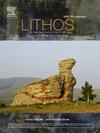Paleocene Katisho ultramafic-mafic-intermediate igneous rocks in the Ladakh Batholith, northern Pakistan: Implications for the transition from intra-oceanic to Andean type arc setting
IF 2.9
2区 地球科学
Q2 GEOCHEMISTRY & GEOPHYSICS
引用次数: 0
Abstract
The Kohistan-Ladakh Arc records terrane accretion and continental growth history from the opening to the closure of the Neo-Tethys. However, its role in the Neo-Tethys evolution and implication for continental crustal growth remain debated. This study present the first comprehensive dataset on the newly identified Katisho ultramafic-mafic-intermediate rocks within the Ladakh Batholith, including field and petrographic features, in-situ zircon U![]() Pb ages and Lu
Pb ages and Lu![]() Hf analysis, mineral chemistry, bulk-rock elemental and isotopic (Sr
Hf analysis, mineral chemistry, bulk-rock elemental and isotopic (Sr![]() Nd) compositions, aiming to have a better understanding the building up of the Kohistan-Ladakh arc and its role in the Neo-Tethys evolution. The Katisho gabbros and granodiorites, located on the northwestern side of the Ladakh Batholith, contain irregular ultramafic enclaves. Zircon U
Nd) compositions, aiming to have a better understanding the building up of the Kohistan-Ladakh arc and its role in the Neo-Tethys evolution. The Katisho gabbros and granodiorites, located on the northwestern side of the Ladakh Batholith, contain irregular ultramafic enclaves. Zircon U![]() Pb dating reveals that the gabbro and granodiorite were emplaced coevally at ca. 66.6 Ma. Geochemical signatures, such as enriched LILE, depleted HFSE, and consistent LREE-enriched REE patterns, show typical features of the arc-related calc-alkaline magmatisim. Their depleted whole-rock Sr ([87Sr/86Sr]i = 0.7041 to 0.7045), Nd [εNd(t) = +2.4 to +3.2], and zircon Hf [εHf(t) = +4.1 to +11.1] isotopic compositions, along with their elemental features (enriched LILE, low FC3MS values [0.4‐–0.6], and Cpx: Grt ratio = 6:1) collectively demonstrate a common origin from a depleted lithospheric mantle source, predominantly spinel-bearing peridotite metasomatized by slab-derived fluids. The diverse type of the intrusions can be attributed to the fractional crystallization of a common primary mafic magma. This study, combined with previous research, concludes that the Paleocene Katisho intrusions were genetically related to the rollback of the Neo-Tethyan Oceanic slab beneath the Asian margin. This magmatic phase marks the transition of the Kohistan-Ladakh arc from an intra-oceanic arc to an Andean-type continental margin, prior the India-Asia collision.
Pb dating reveals that the gabbro and granodiorite were emplaced coevally at ca. 66.6 Ma. Geochemical signatures, such as enriched LILE, depleted HFSE, and consistent LREE-enriched REE patterns, show typical features of the arc-related calc-alkaline magmatisim. Their depleted whole-rock Sr ([87Sr/86Sr]i = 0.7041 to 0.7045), Nd [εNd(t) = +2.4 to +3.2], and zircon Hf [εHf(t) = +4.1 to +11.1] isotopic compositions, along with their elemental features (enriched LILE, low FC3MS values [0.4‐–0.6], and Cpx: Grt ratio = 6:1) collectively demonstrate a common origin from a depleted lithospheric mantle source, predominantly spinel-bearing peridotite metasomatized by slab-derived fluids. The diverse type of the intrusions can be attributed to the fractional crystallization of a common primary mafic magma. This study, combined with previous research, concludes that the Paleocene Katisho intrusions were genetically related to the rollback of the Neo-Tethyan Oceanic slab beneath the Asian margin. This magmatic phase marks the transition of the Kohistan-Ladakh arc from an intra-oceanic arc to an Andean-type continental margin, prior the India-Asia collision.
求助全文
约1分钟内获得全文
求助全文
来源期刊

Lithos
地学-地球化学与地球物理
CiteScore
6.80
自引率
11.40%
发文量
286
审稿时长
3.5 months
期刊介绍:
Lithos publishes original research papers on the petrology, geochemistry and petrogenesis of igneous and metamorphic rocks. Papers on mineralogy/mineral physics related to petrology and petrogenetic problems are also welcomed.
 求助内容:
求助内容: 应助结果提醒方式:
应助结果提醒方式:


